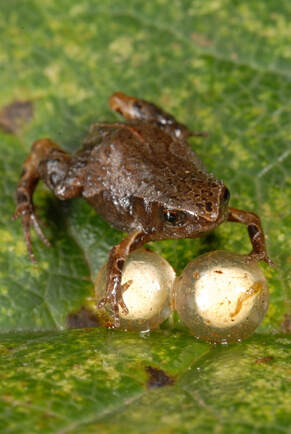
Salamanders are experiencing the greatest decline in numbers, but amphibians throughout the Neotropics are of particular concern, according to Alessandro Catenazzi, FIU biologist and one of the primary researchers on the international project. The team evaluated the status of 8,011 species of amphibians tracked by the International Union for Conservation of Nature (IUCN). Their findings, published this week in Nature, indicate nearly 41percent of amphibian species are threatened with extinction, making them the most imperiled class of vertebrates on the planet, outpacing birds and mammals. Since 1980, at least 37 species have gone extinct, with disease and habitat loss being the primary culprits. The scientists warn climate change is quickly emerging as a major threat, attributing to 39 percent of populations declines since 2004.
"Global emerging diseases increasingly threaten biodiversity worldwide,
and amphibians are one of the most dramatic examples of species extinctions caused by
disease. No other group of vertebrates has been so negatively affected by a single disease" says Catenazzi. "We urgently need better strategies to prevent pandemics and mitigate the effects of introduced disease on wild amphibians"
While the news is not good for amphibians, the scientists do offer hope in this latest
assessment. Enforced habitat protections actually resulted in status improvements for some
species, indicating this should be a conservation priority, especially in regions where
agriculture, timber and plant harvesting, and infrastructure development are ever-present.
Better disease-management tools are also desperately needed to stave off the spread of a
deadly fungal disease responsible for many species declines and to prevent new emerging
diseases.
The Global Amphibian Assessment is the second of its kind, comprehensively assessing the
extinction risk of amphibians. The first assessment was completed in 2004, offering scientists a
baseline of data to measure against for this latest study. Throughout the world, there are 8,615
known species of amphibians with 8,011 being listed on the IUCN’s Red List, a comprehensive
information source on the global conservation status of animals, fungi and plants.
These numbers do not account for the yet-to-be-identified species of amphibians, which are
another area of concern. Many can be very small and reside in remote habitats that are not
immune to disease and the effects of climate change. Catenazzi is very familiar with the elusive
nature of many species, having identified nearly 60 previously unknown species
throughout his career.
According to Dr. Catenazzi, "The Global Amphibian Assessment is our best tool to monitor changes in the conservation status of amphibian biodiversity, and to provide highly vetted and curated
information that can form the basis for management and conservation actions aimed at
preventing the extinction of species".
The current assessment focused on population trends, ecological requirements, threats and
distributional boundaries of amphibians worldwide. While the number of threatened and
extinct species is increasing, the scientists hope this latest research will motivate governments
and conservation agencies to substantially increase their investment and political will for
conservation efforts of the world’s amphibians.
 RSS Feed
RSS Feed